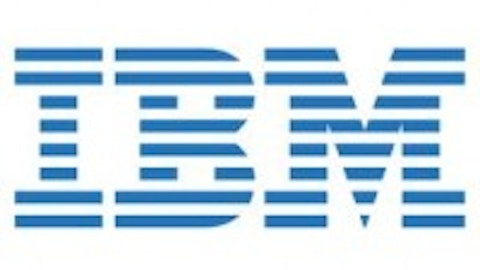Red Hat, Inc. (NYSE:RHT), the world’s leading provider of open source solutions, announced its first quarter results for fiscal 2014 on June 19. The company met expectations on revenue and beat expectations on earnings per share. Looking at its recent shift towards cloud computing and some solid steps taken towards the same, the revenue growth looks pretty strong for the company, which is a common name among enterprises today and has been providing open source solutions for two decades now.
System boot up
The company was founded in 1993, and is now the world leader in providing open-source software products to the enterprise community. Red Hat, Inc. (NYSE:RHT) also develops and offers operating systems powering servers, middleware, virtualization, storage, and cloud technologies. The company uses a community-powered approach to develop and offer reliable and high-performing open source solutions.
The Number code
“The first quarter was a solid start to Fiscal 2014, with both revenue and profitability coming in above the high-end of our guidance,“ stated Jim Whitehurst, President and Chief Executive Officer of Red Hat, Inc. (NYSE:RHT).
The company reported revenue of $363.3 million, which was up 15% year-over-year, along with GAAP reported sales, which were also 15% higher than its prior-year quarter value of $314.7 million. Also, Non-GAAP sales increased in the quarter, unlike margins, which contracted across the board.
Red Hat, Inc. (NYSE:RHT)’s stock price is currently close to its 52-week low:
EPS was better than expected and higher than the same quarter last year. It came in at $0.32, above the estimates of $0.31 per share. But net margin was down by 11%, i.e. 80 basis points lower than the prior year quarter.
Red Hat, Inc. (NYSE:RHT) derives its revenue and generates cash primarily from two sources: (i) subscription revenue, and (ii) training and services revenue.
Charlie Peters, the Executive Vice President and CFO of Red Hat, noted that
During the first quarter, we delivered solid growth in total revenue and subscription revenue. In addition, quarterly operating cash flow grew to a record.
The new peripherals
At the same time, the company has continued to invest in their long-term growth initiatives around the open hybrid cloud to deliver new technologies. It has particularly ramped-up spending in R&D for cloud management, Red Hat Enterprise Linux OpenStack Platform, and Red Hat’s OpenShift platform-as-a-service technologies.
Red Hat recently introduced JBoss Data Grid 6, an in-memory data grid solution, and JBoss Enterprise Application Platform 6 with a new cloud-ready architecture.
JBoss Data Grid 6 mainly focuses on scaling application development for enhanced big data management, while the Enterprise Application Platform has been designed for streamlining and simplifying building enterprise applications thereby moving it to the cloud. Both solutions are available now.
“Red Hat is continuing to invest in important growth initiatives in markets such as virtualization, cloud computing and storage,” affirmed the company’s CFO.
The parallel processors
Oracle Corporation (NASDAQ:ORCL), a major competitor of Red Hat in infrastructure operating systems, also recently reported its earnings. It is still fighting to be in the game, and has succeeded quite well as its management believes in acquisition-driven growth. Being inline with the management’s promise, the company has made a series of partnership moves with Microsoft, Salesforce and NetSuite in order to enhance its cloud capabilities.
Although the company made a late entry into the cloud market only last year, it is still growing strong and possesses huge cash in hand. A 25% market share in the middleware space makes it second to IBM. To make its application software available as an on-demand cloud-based offering, it recently launched Fusion Apps. It is a complete suite of ERP and CRM applications that could help Oracle Corporation (NASDAQ:ORCL) gain additional share in those markets where it competes with Microsoft and SAP.
The graph below shows the increase in quarterly revenue for both Red Hat and Oracle Corporation (NASDAQ:ORCL), as well as fellow competitor VMware, Inc. (NYSE:VMW):
RHT Revenue Quarterly data by YCharts
As seen above, Oracle Corporation (NASDAQ:ORCL) is financially very sound at the moment. It is also restarting its dividend earlier than planned and increasing its quarterly dividend to $0.12 per share. With this recent pull back and partnering with its former rivals, Oracle’s biggest product lines, databases and enterprise resource management solutions can earn quite a handsome return for investors. All this makes Oracle stay competitive and I would suggest a buy, sensing brighter future prospects in cloud offerings.
VMware, Inc. (NYSE:VMW) another giant in the race, provides virtualization infrastructure solutions in the United States and internationally. It has a dominant position in the server virtualization market, ranging from software-defined data centers, client management of mobile devices, to the hybrid cloud.
The company is presently hitting a transition and 2013 looks like a slow year for it. But future years look strong for the company in terms of growth. It is already a world leader in virtualization and also a top player in the cloud. Currently, VMware, Inc. (NYSE:VMW) is 80% owned by EMC, which has plans for working on an organization called The Pivotal Initiative. It combines the assets from both the companies and will be 69% owned by EMC, while 31% owned by VMware, with tools coming from VMware and cash from EMC. The Pivotal Initiative will be the company’s cloud software zone, so it makes sense to sell out your positions in VMware, Inc. (NYSE:VMW) and move to EMC as soon as possible.
Now, having seen this, Red Hat, EMC and VMware, Inc. (NYSE:VMW) look like smaller players providing virtualization solutions to enable organizations to aggregate multiple storage infrastructures, servers and networks together. But for the ones looking out for the complete cloud industry, Oracle Corporation (NASDAQ:ORCL) seems to be the best pick.
Into the future
Looking at the bigger picture and comparing the pros and cons of the moves taken by the company, it looks like a good play for the long term. Red Hat’s revenue continues to grow and it has been seen getting more diversified. Earlier its revenues were derived completely from a subscription model, but as of now the company is focusing more on its cloud computing sector. Red Hat’s OpenStack and OpenShift technologies are its future, and promise handsome rewards for these investments for Red Hat. This will be an early stage to invest, owing to their cloud businesses, but this could prove to be quite fruitful in the future.
Red Hat Enterprise Linux (RHEL) version seven is the most promising future product for Red Hat. Although the company will face fierce competition from Amazon Web services (AWS), it is bound to be a hit, as Red Hat hasn’t made any major releases in the past two years.
Don’t shut down your system now!
Looking at Red Hat’s present goodwill and its future plans for the cloud computing venture, the company stands pretty strong against its competitors. It has the potential of becoming a leading cloud computing company within two years of time. Red Hat’s strengths can be seen in various areas like solid financial position, robust revenue growth and increase in net income. Additionally, with the stock price being close to its 52-week low, I would suggest a buy at the current prices to keep our profit servers up an running.
Rishabh Jain has no position in any stocks mentioned. The Motley Fool recommends VMware. The Motley Fool owns shares of Oracle. and VMware.
The article Start Investing Now to Reach the Cloud originally appeared on Fool.com and is written by Rishabh Jain.
Rishabh is a member of The Motley Fool Blog Network — entries represent the personal opinion of the blogger and are not formally edited.
Copyright © 1995 – 2013 The Motley Fool, LLC. All rights reserved. The Motley Fool has a disclosure policy.







